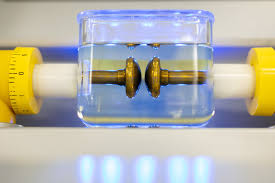Transformer Oil Testing
To assess the insulating property of dielectric transformer oil, a sample of the transformer oil is taken and its breakdown voltage is measured. The lower the resulting breakdown voltage, the poorer the quality of the transformer oil. The transformer oil is filled in the vessel of the testing device.
Minimum breakdown voltage of transformer oil or dielectric strength of transformer oil at which this oil can safely be used in transformer, is considered as 30 KV. The dielectric breakdown voltage test is an important test to determine the withstanding capacity of any insulating oil or liquid.
The limit for power factor of new oil is 0.05%at 25″C, A high power factor in used oil indicates deterioration or contamination or both. Operational hazard is expected from transformer oil with a power factor in excess of 2.0 percent and therefore requires reconditioning or replacement.
PPM stands for Parts Per Million. It is used to measure the weight of moisture divided by the value of oil.
Major contaminates in Transformer Oil Testing:
- Measure the DC resistance of the winding together with the bushing
- Water, dirt, moist cellulosic fibers, and conducting particles in the insulating liquid.
- Polychlorinated biphenyls were formerly used as transformer oil, since they have high dielectric strength and are not flammable.
- Polychlorinated biphenyls (PCBs), polycyclic aromatic hydrocarbons (PAHs), harmful gases and heavy metals.
Some ways to improve Transformer Oil Testing:
- It's important to note that the test is prefer to have as little moisture in the oil as possible because greater moisture weakens the insulating dielectric strength, which increases the risk of flashovers. Special glass bottles are used to collect the oil, which are subsequently sent to a lab for analysis.

